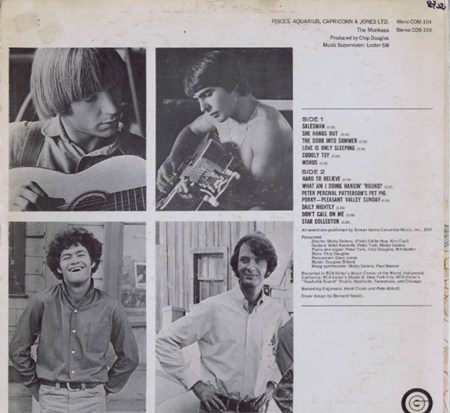
The Monkees, Pisces, Aquarius, Capricorn & Jones Ltd. (Colgems/RCA)
Having proven beyond doubt that they were a real group capable of playing their own instruments and even composing the odd well crafted ditty, The Monkees upped their ambitions on their follow-up to the highly successfull “Headquarters”. They decided to tighten up a bit, replacing Mickey with a real drummer (the highly regarded Eddie Hoh), who, together with bass player Chip Douglas, made up the powerful and rock solid rhythm section that even allowed the four Monkees a couple of left-turns.
Surprisingly the group didn’t write more than a couple of tracks themselves, but the tunes were handpicked by the four members, not stuffed down their throats by Colgems.
Mike Nesmith is the dominant force on this album, being the main vocalist on five of its 12 songs, leaving Mickey with only three and Davy with four. The 13th number, by the way, is a short, spoken track credited to Peter Tork.
Not many people know that The Monkees predated the Beatles by almost two years using the Moog synthesizer on a record. It’s on three of the tracks on “Pisces…”, sounding very much like a novelty I have to admit (especially in the hopelessly silly Moog rave-up “Star Collector”). It still was a remarkable hint of the future, and who would have guessed that The Monkees would be among the pioneers.
The alien sound effects of the Moog wasn’t the only thing that made this, the fourth Monkees-album (in a little over a year), different. They didn’t even try to be cuddly. The opening track, “Salesman”, was a screwball; pushy with a metallic slam attached to it, sung by Nesmith with a strained voice and lyrics that are much darker than they appears to be at first glance.
Then comes a groovy, horn driven piece called “She Hangs Out”, written by Jeff Berry and sung by Davy Jones. It’s got a sting in it and moves way off the lovable track you’d expect from him. And then Nesmith returns with “The Door Into Summer”, another uphill struggle for the teenyboppers, a semi-surrealistic social comment that both attacks materialism and the Vietnam war, not even pretending to be nice. What was going on?

Mickey Dolenz doesn’t enter until track four, “Love Is Only Sleeping”, originally meant to be their next single. Then the record company suddenly realised that the lyrics weren’t about heartbreak and love gone cold at all, but rather about slowly turning a reluctant girl on and ready for sex. At least it was possible to interpret it that way. So it ended up as an album track instead, being replaced by “Daydream Believer”, the original B-side. I guess we can all live with that. “Daydream Believer» became one of the group’s biggest hits, and “Love Is Only Sleeping”, found its perfect slot on side 1 of this eccentric and eclectic album.
Even “Cuddly Toy”, all sugar coated and a typical Davy Jones showcase, has fangs. Written by Harry Nilsson it’s actually a sarcastic homage to a girl who sleeps around… a lot.
The album doesn’t give you any relief until the stylus hits the last track on side 1, “Words”, a wonderful Dolenz/Tork duet with a refrain that sucks you in the moment you hear it.
Don’t know how the average Monkees-fan reacted first time they heard this, but I bet he or she was both bewildered and disappointed. They didn’t know it, but this was what real rock music with a country twist to it sounded like. A little psychedelia too, for good measure. If only people that didn’t like the Monkees had listened, maybe the group would’ve been saved from the rot that set in just a few months later.
I did an interview with Neil Young one evening in 1975. My photographer had bought “Pisces… “ second hand earlier that day and carried it with him in a plastic bag. When the interview was done he asked me for some paper. He wanted Neil’s autograph. I said, “Ask him to sign your Monkees-album”. My photographer found that embarrassing, but I insisted. “He’ll do it, I promise!” So he reluctantly pulled the album out of the bag. Young lightened up. “The Monkees!” he called out, enthusiastically. “That’s a damn good album! Sign it? Sure!” And so he did: “Rock’n’roll forever! Neil Young” A sure fire collector’s item was born.
The second side is an inspired extension of the first: more social comments, more quirky structures. There’s Nesmith’s “Daily Nightly” which concerns itself with the sunset strip curfew riots in 1966, a nasty put-down of groupies (“Star Collector”), the superb “What Am I Doing Hangin’ ‘Round?” and the forever magnificent “Pleasant Valley Sunday” zooming in on the self delusions and empty headed life style of the upper middleclass, the song taking its title from a street called Pleasant Valley Way in West Orange, New Jersey.
A surprisingly strong and eclectic album it is, and all four contribute to its success as a team. Unfortunately they would never try to record an album as a group again.
“Pisces, Aquarius, Capricorn & Jones Ltd.” is The Monkees’ strongest album, and a natural successor to the much loved “Headquarters”. Some might have forgotten how good “Pisces… “ is, some might not even have bothered to listen to it at all. It’s never too late. And you won’t regret it. As the man said, clutching this very album: rock’n’roll forever!
Released: November 6, 1967
Produced by: Chip Douglas
Contents: Salesman/She Hangs Out/The Door into Summer/Love Is Only Sleeping/Cuddly Toy/Words/Hard to Believe/What Am I Doing Hangin’ ‘Round?/Peter Percival Patterson’s Pet Pig Porky/Pleasant Valley Sunday/Daily Nightly/Don’t Call on Me/Star Collector
 |
 |
 |





